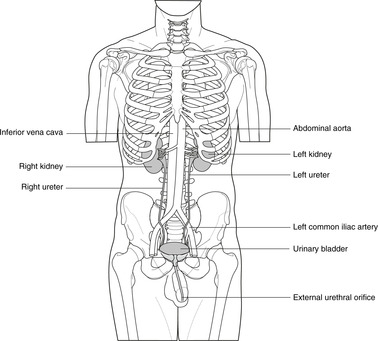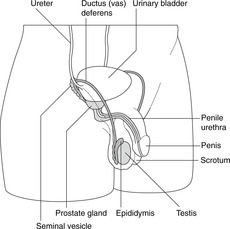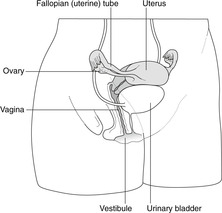Disposition and origin53
9.1. Disposition and origin
9.2. Urinary tract (Fig. 9.1)

Fig. 9.1
9.3. Reproductive tract
Male reproductive organs (Fig. 9.2)
Female reproductive organs (Fig. 9.3)
Self-assessment on Section 1 (Chapter 1, Chapter 2, Chapter 3, Chapter 4, Chapter 5, Chapter 6, Chapter 7 and Chapter 8)
Single best answer questions
Questions 10–25
![]()
Stay updated, free articles. Join our Telegram channel

Full access? Get Clinical Tree



Urogenital system
9.2 Urinary tract53
9.3 Reproductive tract53
The urinary and genital components of the urogenital system are derived from common embryological sources. Their functions are at first sight dissimilar: the urinary system is mainly for excretion of waste products from the blood stream, and the genital system for reproduction. In mammals, organs of both systems are confined to the lower abdomen, pelvis and perineum.
The urogenital system is confined in mammals to the abdomen, pelvis and perineum. The two components, urinary and genital, have a common embryological origin.
• The gonads and kidneys (and adrenal cortex) are from embryonic tissue on the posterior coelomic wall (the coelom is in the early embryo what will, in this region, become the abdominal cavity). This common origin is reflected, despite subsequent movements during development, in the blood supply, lymph drainage and, for the adrenal cortex and the gonads, the secretion of steroid hormones.
• Much of the duct systems of the urogenital organs originate with the terminal portion of the gut: they are either cloacal derivatives, or they open into the cloaca (Latin: sewer). These structures include:
– in both sexes, the urethra, bladder, ureters, collecting ducts of the kidney
– in the female, the vagina, uterus and Fallopian tube
– in the male, the ductus (vas) deferens and seminal vesicles.
Urine is produced in the right and left kidneys and passes through the right and left ureters to the bladder. It is expelled from the bladder through the (midline) urethra. This is short in the female and longer in the male, traversing the penis.
The paired testes develop high on the posterior body wall and before birth descend to the scrotum. Spermatozoa are produced in the testis and at ejaculation are propelled along the ductus (vas) deferens on each side to join the (midline) urethra in the substance of the prostate gland. They travel to the tip of the penis in the urethra.
The ovaries also develop high on the posterior body wall but do not descend as far as the testis so that the ovaries remain in the lower abdominal cavity. The uterus and Fallopian (uterine) tubes develop from a paired tubular system that partially unites. Those parts which remain paired are the Fallopian tubes; those that unite form the uterus in which the fetus develops, and the vagina which receives the penis at copulation and through which the baby is born.
10. In the anatomical position, the palms of the hands face:
a. anteriorly.
b. inferiorly.
c. posteriorly.
d. superiorly.
11. Straightening the upper limb at the elbow joint is
a. abduction.
b. adduction.
c. extension.
d. flexion.

